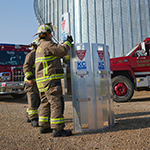Grain bin safety
Reduce bin fires with quality storage practices
Preventing grain bin fires starts with maintaining grain quality in storage.
Grain bin fire prevention starts with quality storage practices.
Grain bin safety starts with maintaining grain quality in storage. Often times, poor quality grain in the bins can quickly lead to fires and explosions.
Consider this:
- Poor quality grain is generally a lighter test weight and more susceptible to insect damage; the more it is handled, the more likely it is that the grain will have kernel breakage and damage. These conditions contribute to grain getting so hot, it is not possible to convey it safely.
- ‘Hot spots’ in grain increases the potential for grain fires during extended storage periods.
- Storage and handling of poor quality grain increases the potential for fire and thus personal injury due to exposure to smoke and heat. These conditions can also put employees at risk due to the need to perform hazardous tasks like bin entry.
- Proper grain management should always include a zero entry mentality, especially when smoke or hot spots are noted in a bin.
- Other effects of bin fires caused by ‘out of condition’ grain can include extreme loss of market value, increased property damage, increased potential for employee injury and additional scrutiny or fines from OSHA.
The best course of action is to do everything possible to properly manage grain in the bins. It should be noted that the safest course of action is always to stay out of grain bins, however, in case of a fire, this message is especially true. Grain bin fires are very dangerous and have the potential to produce an extremely hot burn. With proper aeration and cooling of stored grain, farmers and commercial grain handlers can help prevent conditions that lead to bin fires.
Trending now
Need help? Email us or call us at 800-260-1356.

 >
>

 >
>
 >
>